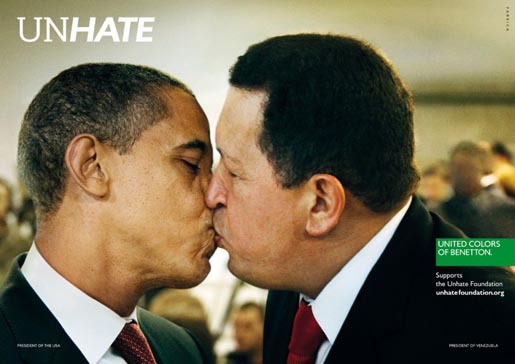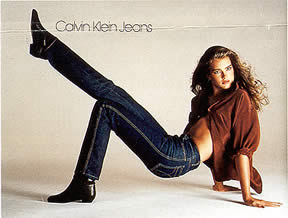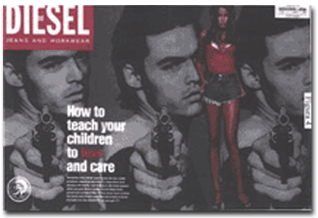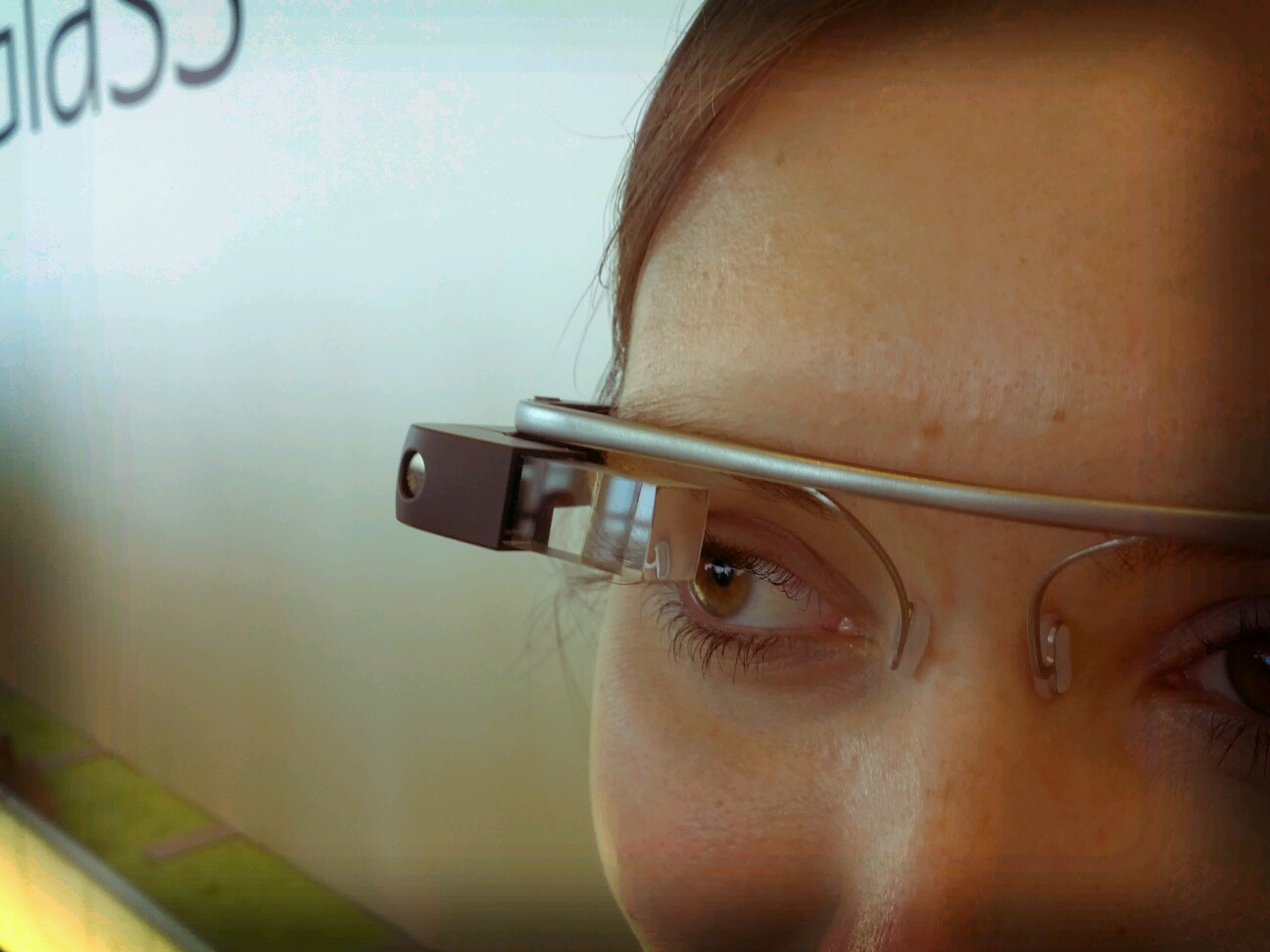
Visual Persuasion in Advertising, Public Relations, and Journalism
Review the previous lesson QUIZ
How does the media visually persuade us? What is the difference between persuasion and propaganda?
Shock Advertising or Shockvertising defined: Deliberately creating messages that shock and offend by violating social norms or ideals. This could be graphic images or words that are risque or offensive. The purpose is often to reach a particular market, or create a buzz( youth) and also to be noticed in a cluttered marketplace.
 |
|
 |
|
 |
|
 |
|
Shock Advertising
|
|
Advertisements and Social Issues
|
|
Persuasion or Propaganda?
Advertising, public relations and journalism are closely related-all use persuasive techniques to support ideas, change attitudes. However, blurring of lines between corporate and editorial is a serious concern today
Belief is the information a person has about a person, place, object or issue that forms their attitude
Attitudes are general long lasting positive or negative feelings about person, place, objects or issues
If information is limited or a source isn't trusted, a belief can become an enduring attitude that leads to stereotypical generalizations
The Distinction between Persuasion and Propaganda:
While Persuasion uses facts and emotion to appeal to a person to change their mind or promote a behaviour, Propaganda uses emotion and one-sided and many times non factual information/opinions that are portrayed as facts, to change minds or promote particular behaviours. While persuasion is socially acceptable; propaganda is questionable and is often associated with thought control.
Propaganda: the goal is to influence another through use of one-sided argument, often using selected facts that may not include the whole story. Presenting a loaded emotional response so that another does not use rational thinking. Using words, pictures, multimedia, to influence another with debatable techniques.
Walter Lippmann
Walter Lippmann in Public Opinion (1922) talked about how pictures could be used to change a person's attitude. First in importance in changing minds is images and next the words that conjure up a picture. He believed that images could change attitudes as people related them to their own situations.
A bit about Lippmann
In 1922, Walter Lippmann published an influential book entitled fact. In the book, Lippmann was very suspicious and critical of any model of democracy that placed excessive faith and power in the hands of the public. He argued that participatory democracy was unworkable, that the democratic public was a myth, and that governance should be delegated exclusively to political representatives and their expert advisors. Based on empirical evidence about the efficacy of political propaganda and mass advertisement to shape people's ways of thinking, Lippmann contended that public opinion was highly shaped by leaders. Lippmann called this process of manipulation of consciousness 'the manufacture of consent', a concept that Noam Chomsky would popularize many years later. Lippmann argued, first in 'Public Opinion' and later in 'The Phantom Public', that since ordinary citizens had no sense of objective reality, and since their ideas are merely stereotypes manipulated at will by people at the top, deliberative democracy was an unworkable dogma or impossible dream. In his view, the most feasible alternative to such democracy consisted of a technocracy in which government leaders are guided by experts whose objectives and disinterested knowledge go beyond the narrow views and the parochial self-interests of the average citizens organized in local communities. Lippmann saw advocates of participatory democracy as romantic and nostalgic individuals who idealized the role of the ignorant masses to address public affairs and proposed an unrealistic model for the emerging mass society. He opposed such a model with his own model of 'democratic realism' based on political representation and technical expertise. (source: http://fcis.oise.utoronto.ca/~daniel_sch/assignment1/1922lippdew.html )
All human communication uses persuasion and propaganda to mold or change a viewer/s attitude
Edward Bernays and Propaganda URL: https://www.youtube.com/watch?v=tru6uiWs8Yo
The Role of Persuasion
Persuasion is considered a socially accepted way to change other's minds. Government tries to change people's minds through the press through its public relations
When a government tries to sell its story and the press wants to report objectively the result is a clash.
Hopefully the press and today the public through social media can keep a government and large corporations honest; However the media itself is questioned for its bias.
The Role of Propaganda
Originally propaganda did not have a negative connotation. The word "propaganda" began as a neutral word for spreading an idea to a large group. Governments have used the technique to convey their version of the truth- this has given the word its negative connotation.
The word is used as 'the art of lying' or "the deliberate attempt by the few to influence the attitudes and behaviour of the many by manipulation" and it's been attached to thought control -others now use it to get people to do what they would not have otherwise done. Some believe that 3/4 of content of media contains some propaganda
The difference between persuasion and propaganda is the social definition of the words
In 2006 ads appeared on Middle Eastern television stations using advanced graphics to discourage suicide bombers. The producers of the ads are hard to track and the US did not specifically deny producing them. During war, imagery produced typically shows the one side as good and the other as bad. It is typical for governments to demonize the other side to get the support of people to sign up or give money to support "the cause."
In July 2017 John Oliver warned of a takeover of local media Television in the US by Sinclair Broadcasting.The company was trying to take over Tribune Media to expand its empire. Sinclair was forcing local news outlets to run prepakaged content that was against political correctness and multiculturalism. Read about it here John Oliver takes on Sinclair, The Guardian
Visual Persuasion in Advertising
Advertising can be defined as "any form of nonpersonal presentation and promotion of ideas, goods and services by an identified sponsor"
There are two types of advertising: commercial and noncommercial
Commercial ads range from a person's classified car ad to display ads or commercials promoting products
Noncommercial ads include government notices and public service (PSA)
The Advertising Council is concerned with ethical advertising, but many of the rules are voluntarily maintained rather than enforced. Today there is so much choice in the media that we attend to; therefore, advertising and media have adopted new techniques to get attention. We can flip channels, PVR shows, watch things online; the audience is harder to track and influence through the old traditional means, so companies have gotten more creative.
Advertising/News Media Controversial Tactics
The purpose of advertising is to attract attention, arouse interest, stimulate desire, create opinion and move a person to buy.
In the American 2004 election Bush used emotional images of 9/11 events , and his team produced short video's (VNR: Video News Release) that looked like news but were actually manufactured- many stations aired the reports as if they were news. The name VNR fell out of favour but they are still around -today they are called Influencer Media Packages
in the early 1900's laws were created to distinguish between news and advertisement, advertisements should have that word to identify them when it is not obvious, but advertisements have become entertainment- infomercials that look like talk shows appeared in 1984- the print version is called an "advertorial"
Stereotyping/Health Concerns: 1950s ads even with regulations showed the successful anglo man with a desirable woman at his side; consumer movements against sexist ads, and unhealthy products like cigarettes created change on TV. When it was shown that in the US more kids recognized Joe Camel more than Mickey Mouse a lawsuit was launched and the ads ended
Product Placement
Vance Packard's book The Hidden Persuaders in 1957 and Bryan Wilson Keyes Media Sexploitation in the 70s brought the concern of subliminal messages to the public even though a key research event by James Vicary was proved to be faked.
Product placement has become more and more prevalent with zapping of commercials and fragmentation of audiences and the rise of the internet
Sales of Reese's Pieces after ET increased 65%; in Moonstruck Cher drank Mum's champaign today movies as well as TV especially reality is full of product placement.
On websites"advertorials" appear as content, pop-up, pop-under's
Some have created websites for movies to make them appear real -example Blair Witch 1999. Today most new blockbusters have websites that cross the boundaries or real world and the movie version of real
Augmented Reality
Digital imaging is used to place ads in ballparks as well as old TV shows
Augmented Reality- when the real world is layered created a mixed reality again changes out view. Mobile applications for your smartphone can use your location and layer your view through your mobile device. We can now see all the bars that sell Stella Artois with their app, we can see dinosaurs come to like with a app inside a museum and with Google glass every moment of our lives can be augmented with incoming data right before our eyes
Facial recognition can be used to appeal directly to us as we pass by a storefront not unlike Tom Cruise in Minority Report.See a 4 minute video on Google Glass and the Future of Augmented Reality https://www.youtube.com/watch?v=qdD5-woi_os
What is real?
Critics argue that the average person can't tell the difference between ads and news and entertainment; others suggest ads mirror the society- we get what we deserve.
The media conflict - they present the news, try to make change but they are sponsored by advertising
After Tom Cruise wore Ray Bans in Risky Business sales soared
Google Glass
Visual Persuasion in Public Relations
What is reported isn't always as important as how it is reported. The job of public relations (PR) is to put a positive spin on things. A celebrity gets arrested and a PR person helps that person sort out their problem. Public Relation firms have also been involved in work to promote a political agenda that leads a country into war. During crisis PR person is at front. It is estimated that 50% of news is generated by public relations people -press release, press conference
Public relations was a key to getting US public on side the war effort in World War I - the Committee on Public Information was formed 5 million was used to create movies, posters and men called "Four minute men" traveled country making speeches to support the war. The information was inflammatory and often false with rumoured atrocities.. Americans learned to hate the Germans- journalists were not permitted to write anything critical of the propagandaEdward L Bernays worked for CPI and after war became known as founder of PR. The mass media was used to influence -in 1920s press agents were responsible for company image. The rich and famous hired press agents to ensure that history looked favourably on them -ex- John D Rockefeller, Henry Ford
In 1970s ad agencies realized they were competing with public relations and began buying PR firms--usually they are kept separate. Public relations use grew in politics in the 70s- PR firms in US have been accused of using photo ops and scare tactics. Lobbyists are paid by corporations to influence law makers. In US there are more than 800,000 PR people. Editors often fill newspapers with stories written by PR people- a PR person's job is to get free press-they like newspapers as they get reread or resent from online newspapers
Staging - Constructing ImagesToday, most of us have heard the term "photo op" which refers to a photo opportunity. In a photo op we can see a carefully orchestrated picture of what someone wants us to think about a particular thing, person or event. It is a constructed image.
Events are staged to get attention-political victory speech, Bush landing on aircraft with Mission Accomplished sign above. Guest appearances on TV are more style over substance-PR people coach guests on behaviour.
Video News Releases (VNRs)-today they are called Influencer Media Packages provide picture and story as news story so viewer doesn't know that it is produced by person with a motive. Expanded news releases like infomercials are disguised as news. Some companies that own large numbers of local news stations dictate news content not unlike VNRs.
PR is criticized because average viewer can't tell the difference- the spin doctors on "Spin alley"
Enron was paying several journalists to sit on boards and write speeches. Many news commentators have made speeches for corporate interest groups. In spite of all this negativity about the public relations industry, there are hard working professionals in the field who work hard to follow a code of ethics
Test your self. Can you distinguish real news vs fake news? Try Factitious to see.
Influence of Advertisers
Communications industry gets income from advertisers. Advertisers try to influence what is in media- 93% of editors had threats from advertisers that they would cancel ads. In the 1940s ads took up 55% of space in newspapers today it is more than 68% and about 90% in free newspapers, but the whole print media is in jeopardy with more an more views accessing news online. When USA today introduced colour in weather maps it was to show advertisers the effect of colour
Soft news is used to attract consumers- celebrity journalism-gossip news- infotainment- news show devote time to what's going on in reality TV shows- news shows use tease to keep you watching-tabloid journalism- OJ Simpson, Michael Jackson, missing girl in Aruba, 9/11 coverage, Janet Jackson's nipplegate, 24/7 coverage of trivial content.
What once was news is now marginalized behind the infotainment that is popular. We often know more about the latest celebrity scandal than we know about real world events.
__________________________________________________________________________________
Sources/ Resources
Visual Communication: Images with Messages by Paul Martin Lester
History of Ad Regulation http://www.asa.org.uk/asa/about/history/Reflecting+public+expectations+avoiding+censorship.htm
The 15 Most Offensive PETA Advertisements, Business Insider http://www.businessinsider.com/peta-shocking-controversial-ads-2011-10?op=1
Shock advertising http://www.brandchannel.com/features_effect.asp?pf_id=84
Shock Advertising http://www.personal.psu.edu/users/e/e/eew122/shock/intro.html
Shock Advertising: A Poke in the Brain http://journal.aiga.org/content.cfm?ContentAlias=_getfullarticle&aid=1362039
Benetton Unhate Kissing, The inspiration Room http://theinspirationroom.com/daily/2011/benetton-unhate-kissing/
Benetton Pieta in AODs campaign, The Inspiration Room http://theinspirationroom.com/daily/2007/benetton-pieta-in-aids-campaign/
Fox News(?) on Shock http://www.foxnews.com/story/0,2933,191727,00.html
Shockvertising http://news.bbc.co.uk/1/hi/special_report/1999/02/99/e-cyclopedia/611979.stm
USA Today Ads Highlight Cultural Differences http://www.usatoday.com/money/advertising/2003-06-19-xtreme_x.htm
We on Death Row Benetton's (radio program) http://www.theconnection.org/shows/2000/01/20000113_a_main.asp
PBS Death penalty debate Benetton's https://www.pbs.org/newshour/extra/features/jan-june00/deathpenalty.html
Benetton http://www.jednet.co.uk/tottonsep2000/hncadv1/benettonad/hncbenetton1.html
Benetton- their own site http://press.benettongroup.com/ben_en/about/campaigns/list/
Benetton Catalog of Killers (see a short video) http://www.cbsnews.com/stories/2000/05/30/60II/main200723.shtml
Diesel Ads http://www.designboom.com/eng/interview/rosso.html
Semiotic analysis of Diesel Ads http://www.aber.ac.uk/media/Students/lmg9302.html
Cohersion: Why we listen to what they say https://www.pbs.org/wgbh/pages/frontline/shows/cool/rushkoff/coercion.html
Public Opinion by Walter Lippmann http://xroads.virginia.edu/~Hyper/Lippman/cover.html
Product Placement http://www.usatoday.com/money/media/2004-10-14-tv-product-placement_x.htm
http://www.adjab.com/category/product-placement/
http://www.snopes.com/business/market/mandms.asp
Hip Hop and product placement timeline http://www.cbc.ca/rhymepays/product_place.html
Brand Channel tracking product placement http://www.brandchannel.com/brandcameo_films.asp
Four Minute Men http://www.rootsweb.com/~neburt/bcww1/bcww1p30.html
more recent propaganda http://www.newshounds.us/2005/12/01/fox_news_propaganda_about_the_propaganda.php
Edward L Bernays founder PR http://www.prmuseum.com/bernays/bernays_1923.html
Father of Spin http://www.prwatch.org/prwissues/1999Q2/bernays.html
Propaganda Resources http://www.classroomtools.com/proppage.htm
Google Glass and the Future of Augmented Reality https://www.youtube.com/watch?v=qdD5-woi_os
 see
more shock ads at
see
more shock ads at 



